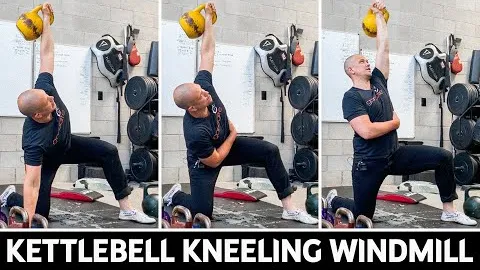Kettlebell Kneeling Windmill Exercise: A Comprehensive Guide
The Kettlebell Kneeling Windmill exercise is a dynamic full-body exercise that targets multiple muscle groups and enhances overall strength, mobility, and stability. This exercise can be performed by individuals of all fitness levels and has various modifications to accommodate different needs. In this article, we will delve into the technique, benefits, and variations of the Kettlebell Kneeling Windmill exercise.
Technique
- Starting Position: Begin by kneeling on the ground with your legs shoulder-width apart. Place the kettlebell beside your front leg, ensuring that your feet are firmly planted.
- Gripping the Kettlebell: Reach across your body with your hand on the same side as the kettlebell and grasp the handle with a firm grip.
- Lifting the Kettlebell: Using the opposite hand as support on the ground, lift the kettlebell off the floor by extending your arm straight up towards the ceiling.
- Hinge at the Hips: Rotate your torso and hinge at the hips to lower the kettlebell towards the inside of the front leg. Keep your back straight and maintain proper alignment throughout the movement.
- Lowering the Kettlebell: As you lower the kettlebell, extend your arm towards the ground, allowing your upper body to rotate while keeping your eyes on the kettlebell.
- Return to the Starting Position: Push through your front leg, engage your core, and lift the kettlebell back up to the starting position. Repeat the exercise for the desired number of repetitions before switching sides.
Benefits
- Full-Body Workout: The Kettlebell Kneeling Windmill exercise engages various muscle groups, including the shoulders, back, core, glutes, hamstrings, and quadriceps. This comprehensive engagement leads to improved overall strength and stability.
- Core Stability: As you perform the Kettlebell Kneeling Windmill exercise, your core muscles are constantly engaged to maintain proper posture and stability throughout the movement. This exercise helps develop a strong and stable core.
- Shoulder Mobility: The exercise involves rotating the shoulder joint, improving its mobility and flexibility. By incorporating this exercise into your routine, you can enhance your shoulder mobility and reduce the risk of injuries.
- Improved Hip Mobility: As you hinge at the hips during the exercise, your hip flexors and hamstrings are stretched, promoting increased hip mobility. This is especially beneficial for individuals who sit for long periods or have tight hip muscles.
- Functional Movement Pattern: The Kettlebell Kneeling Windmill exercise mimics movements required for various daily activities, such as lifting objects and reaching across the body. By regularly practicing this exercise, you can improve your functional strength and movement efficiency.
Variations
- Kneeling Windmill with Lightweight: If you are new to the exercise or have limited mobility, start with a lighter kettlebell to master the movement and ensure proper form. As you gain confidence and strength, gradually increase the weight.
- Standing Windmill: Once you have mastered the kneeling version, you can progress to a standing windmill. This variation challenges your balance, coordination, and core stability even further.
- Double Kettlebell Windmill: For a more advanced variation, perform the exercise with a kettlebell in each hand. This increases the demand on your core and upper body strength, providing an additional challenge.
- Reverse Kneeling Windmill: Instead of kneeling on the ground, start in a standing position with the kettlebell positioned on the side of your front leg. Hinge at the hips and lower the kettlebell towards the inside of your leg while keeping your back straight.
- Weight Plate Windmill: If you don't have access to a kettlebell, you can perform a similar movement using a weight plate. Hold the weight plate with both hands and follow the same technique as the traditional kettlebell windmill.
Precautions and Tips
- Start with a lighter weight and gradually increase as you gain strength and confidence.
- Maintain proper form and alignment throughout the exercise to prevent injuries.
- Engage your core muscles throughout the movement to ensure stability.
- If you have any pre-existing shoulder or back injuries, it is advisable to consult a fitness professional before attempting this exercise.
- Always warm up adequately before performing the Kettlebell Kneeling Windmill exercise.
Incorporating the Kettlebell Kneeling Windmill exercise into your fitness routine can provide numerous benefits for your overall strength, mobility, and stability. Consider adding this dynamic exercise to your workouts and experience the positive impact it can have on your physical performance. Remember to practice proper form, progress gradually, and listen to your body's limitations. Embrace the challenge and reap the rewards of this versatile exercise.
